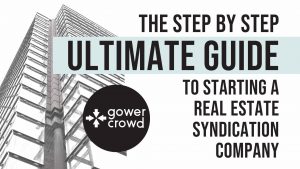Most commercial real estate developers have come around to the idea of utilizing social media to raise capital for their deals. They’re quick to turn to Facebook, Instagram and even Google when it comes to advertising.
However, few realize the power of LinkedIn advertising to find prospects and convert them into becoming investors.
Certainly there is a learning curve when learning how to leverage LinkedIn ads to raise money for commercial real estate deals, but that is true of all social media platforms' paid advertising, and once you’ve figured out how the advertising on LinkedIn works, it can be wildly effective in connecting you to potential investors.
In this article, we look at which developers should consider using the platform and why, including an overview of how to get started raising money on LinkedIn today.
n.b. Before going any further on this or any other commentary about advertising to raise money for real estate deals, it is important to keep in mind that, as with all CRE equity raising, patience is key. If you need to raise money in a hurry, advertising is not likely to be your friend because it takes time to nurture a prospect before they invest. If you are able to acquire 1,000 leads from a LinkedIn ad campaign, you may convert some to your current deal, but the bulk of the value you gain from the campaign will come down the road, on future raises once you have had time to cultivate a (digital) relationship with those leads.
Looking to expand your Real Estate Investing knowledge? GowerCrowd’s insights are detailed ensuring you learn all you need to know.
Why You Should Use LinkedIn Advertising to Raise Money for Commercial Real Estate Deals
Given the nuances of LinkedIn advertising – and as we’ll discuss in more detail, the cost of doing so – many developers bypass the platform altogether. Instead, they focus their attention on Facebook and Google advertising. Admittedly, Facebook and Google advertising can be a bit easier to navigate, and both have broad audiences. That said, LinkedIn continues to be an effective tool for commercial real estate developers looking to connect with potential investors.
What’s more, LinkedIn ads can generate leads that are more likely to convert to investors relative to other social media platforms.
LinkedIn Advertising vs. Facebook or Google Advertising
• Uses for Each Platform
Facebook and Google ads continue to prove successful for those looking to sell less expensive items, such as clothing or electronics. These platforms are successful in different ways. Facebook, for example, allows you to narrowly target an audience based on what someone’s interested in, such as leisure travel, for example. Google ads can be used to target people based on what they’ve searched for previously. Neither platform, though, is as useful as LinkedIn when it comes to raising capital for commercial real estate deals because neither offers the same quality of demographic targeting.
LinkedIn is unique in that there are many business professionals and investors using the platform and they use is specifically for business purposes unlike Facebook, which is more socially oriented, or Google, which is a search engine and so covers the broadest possible range of interests.
People turn to LinkedIn as a trusted source of information about things happening in their industry and specifically because they want to learn more about business opportunities. Therefore, advertising a real estate deal on LinkedIn captures the attention of those in the commercial real estate industry, or others who self-identify as investors, because those folk are on the platform specifically to discover exactly that type of opportunity a commercial real estate syndicator is advertising.
• Audience Reach
Although LinkedIn is an effective tool, it does, of course, have its downfalls. One significant downfall is people simply don’t spend as much time on LinkedIn as they do on Facebook or Google, which creates less ad inventory. With less ad inventory, it makes the price per ad more expensive relative to the other platforms. Which brings us to…
• Cost of Advertising
The cost per click for an ad is significantly higher on LinkedIn than Facebook or Google. Some may even argue that LinkedIn ads are artificially expensive. For perspective, a Facebook or Google ad may only cost a few cents per click whereas a LinkedIn ad can easily cost someone several dollars per click. We’ll touch upon this in more detail below however, before we do, keep in mind that when you're advertising a deal to attract investors a 'conversion' is NOT a 'click.'
A conversion is when an investor signs a check or wires an investment and so it is important to be sure that you are measuring the right metrics when using paid advertising to raise capital.
The Benefits of Using LinkedIn Advertising to Raise Capital
• Developers Can Narrowly Target an Audience
LinkedIn allows people to be highly specific with their targeting. For example, you can search for people who have self-identified as “real estate investors” or “real estate fund managers”. It is much easier to fine-tune your audience on LinkedIn vs. other social media platforms, which have a bigger but significantly broader audience that is more difficult to wade through.
This means that, although each click on a LinkedIn ad is more expensive than other platforms, those clicks tend to be among people who are uniquely interested in the product you’re selling and therefore, more likely to convert to buyers (or in this case, to convert to investors in your commercial real estate deal).
• A/B Testing Can Result in Highly Effective Ads
Split testing can be done on virtually any platform, but it is particularly useful for those looking to engage a specific audience on LinkedIn. By way of example, someone may do A/B split testing of ads on Facebook by creating 10+ ads and targeting multiple audiences at one time. It’s not unheard of to have 100+ combinations running at the same time when utilizing Facebook ads.
Split testing on LinkedIn is significantly more nuanced, in large part because you’re able to more narrowly define your audience from the outset. Moreover, the cost of advertising is so expensive on LinkedIn that few people will want to run multiple ad campaigns at once. Instead, most people will start with a simple A/B split test, which is easier than running multiple combinations and can yield terrific insights for those learning how to be most effective with their advertising dollars. We’ll touch upon this in more detail below.
The Cons of LinkedIn Advertising When Raising Capital for CRE Deals
• Ads are Expensive On a Per Click Basis
As we mentioned earlier, LinkedIn advertising is more expensive – on a click per click basis – than advertising on either Facebook or Google. By some estimates, LinkedIn ads costs four to five times more per click than an ad on Facebook. Therefore, when advertising on LinkedIn, it is important to really understand your audience so you are targeting the right people instead of wasting precious marketing dollars on clicks that don’t convert.
That said, the quality of the leads is generally thought to be higher on LinkedIn and so a real conversion, as stated above, is not the traditional marketer's measure, the click-through-rate, but the actual amount invested at the end of the day. Consequently, the performance of an ad campaign on LinkedIn - or on any platform - can sometimes not be known until a raise has closed and you are able to join the dots between your advertising media and actual investments.
• Your Business Needs a Good LinkedIn Profile
Ads on LinkedIn are published by companies, not individuals so when people see the ad they will be directed to the company placing the ad, not to an individual. This means that the company advertising needs to have a decent profile and, ideally, some sort of an audience already built up. Often, the principals of a company will have thousands or tens of thousands of connections, but their company LinkedIn page has a fraction of that. Having company followers gives the ad legitimacy: if someone looks to see who’s promoting an ad, and the company only has no followers, they may question the source of the information.
It’s always best when the ad is coming from a company that people already know and trust, which can be a shortcoming for some developers looking to get started raising capital with LinkedIn advertising. It usually takes a few hundred followers to pass thee legitimacy sniff test, if you will.
However, you can compensate for this if you have a vast personal following but very few company followers by ensuring that your best content is posted on your company profile and that each post has a link back to your website. This way, even if you don't have a large number of company followers on LinkedIn, once on your company profile, a prospect can learn more about you from the high value information you have posted there. That will serve you as well, if not better, than having follower's on your company profile - think of it as a billboard advertising your capabilities and experience.
• There’s a Learning Curve to LinkedIn Advertising
LinkedIn advertising can be a tricky nut to crack. Given how expensive an ad campaign can be, it’s important for a developer to really hone in on who their audience is so they can target the appropriate people. You must also study the analytics to determine how well your ads are performing to avoid overpaying for ads that don’t lead to conversions. Those who invest the time in understanding how LinkedIn ads work will find that LinkedIn can be a great way to raise capital for commercial real estate deals.
Get access to our FREE weekly newsletter exclusively covering the latest updates from the real estate crowdfunding world
Who Uses LinkedIn Ads to Raise Money for Real Estate Deals?
LinkedIn ads are used by companies of all sizes, large and small alike. An estimated 90 percent of LinkedIn advertising is done among companies doing B2B sales. However, that shouldn’t deter real estate sponsors, such as those crowdfunding a deal, from using LinkedIn ads. On the contrary, B2C campaigns can also be successful on LinkedIn.
Yet given the cost of LinkedIn advertising, B2C campaigns tend to make the most sense for real estate sponsors looking to raise capital for large deals, or funds, or who otherwise will reap long-term value be connecting with the prospects they’re targeting with their ads. In these instances, companies can usually justify spending more per click up front than they might be willing to do for a small deal or limited product offering.
Related Article: Optimizing LinkedIn to Find Investors
How to Use LinkedIn Ads to Raise Capital for Real Estate Deals
• Create Investor Avatars
In terms of targeting an audience, LinkedIn’s algorithm is simply not as sophisticated as those used by Facebook or Google. LinkedIn has a hard time finding an audience for you, but if you know who your audience is (as noted above), LinkedIn can then be very effective in targeting those people on your behalf. It is, however, a manual process for building audiences - and quite laborious to getting it right.
Therefore, in order for a sponsor to be successful in raising capital for a commercial real estate deal on LinkedIn, they must be able to define their target audience by job title, industry and company size. When getting started, consider creating investor avatars that allow you to describe your target audience(s) with a high degree of specificity.
Pro Tip: We have discovered that among the best audiences to target on LinkedIn are Groups. Though we have not found them to be of much use otherwise, they tend to be populated by people who have specifically identified themselves as being interested in a particular topic. When the right groups are targeted (an art form in itself) we have found members to be more receptive to commercial real estate pitches, reducing conversion costs and increasing capital raises.
• Determine Your Ad’s Offering
The most successful LinkedIn ads offer something of high value to their target audience. When considering a LinkedIn ad campaign, a sponsor should determine what they’re going to offer via the ad. The offer must be attractive enough that people will be willing to opt-in to providing you with their contact information, and therefore, enter your sales funnel.
For example, an ad that asks people to “click here to speak with a sales rep” is not going to be particularly successful on LinkedIn. People are not using LinkedIn to engage with vendors in that manner. People use LinkedIn to learn, grow, and connect with others in their industry. In a similar vein, a real estate developer wouldn’t want to ask someone to “invest now”. These requests are too heavy, particularly if you do not have an already strong relationship with the prospect.
Instead, a sponsor looking to raise capital for a commercial real estate deal might put out an ad linking to a white paper they’ve written on a specific pain point for investors – such as how to defer paying capital gains tax upon sale of an investment property. The white paper would help position the sponsor as a thought-leader in the industry, and eventually, the reader may be compelled to invest with the sponsor. Whatever the case may be, the ad must offer something meaty enough to get the audience’s attention, provide value, and capture the name and email address of the prospect for ongoing nurturing prior to an actual capital raise.
• Create Your Lead Generation Strategy
There are generally two ways to generate leads with LinkedIn advertising. The first is to use an ad that hyperlinks to something on your company’s website. This is where someone may be introduced to the company for the first time, and where, in exchange for giving you their name and email address, they’ll be able to gain access to some high value, informative data about your background, experience, track record and investment philosophy.
An alternative strategy is to utilize LinkedIn’s built-in lead generation form. Marketing agencies familiar with LinkedIn advertising say this generally has a much higher conversion rate, sometimes 10-50% higher than routing someone to your own website. The reason is because LinkedIn’s lead generation tool can autofill information on the prospect’s behalf based on the detail in their LinkedIn profile (e.g., name, company, title, email address and so on). This reduces the effort needed on behalf of the prospect.
The downside of this strategy, though, is it does not bring people to the company’s website where they might learn much more about the firm, their experience, and their product offerings. Another downside to watch for is that by making it too easy to complete a form, a prospect may complete the form and not open your automated follow-up email for a few days, forget that they'd completed the form and think your communication might be spam.
Pro Tip: If using LinkedIn automated forms (this applies to Facebook and other platforms also) while the idea of facilitating a conversion by offering auto-completed forms might be compelling, you do want high quality leads and the way to get them is to make sure that they do have to 'work' somewhat to give you their information. For example, maybe auto-fill the fields you really want, such as name and email address, and then include a field asking if they are accredited that requires a manual response.
• Test Your Ad’s Efficacy
As mentioned above, A/B split testing is effective and necessary when engaged i any advertising campaign and LinkedIn is no exception though, on LinkedIn, there are some nuances to be aware of.
To determine the efficacy of your ad, create just two separate LinkedIn ads with different copy or different images. Then target a vast array of audiences. In essence, you’re creating separate focus groups to determine which ad works better, and which audiences are most likely to convert to actual leads (and by extension, the quality of those leads).
Once you discover which ad works better, drop the under-performing ad and replace it with a new challenger and run that and the earlier winner against your best performing audiences. That way you constantly iterate your campaign to discover the best possible combination of ad copy, image, and audience, increasing conversion and reducing costs.
An important note, however: the ad with the highest click through rate doesn’t necessarily correlate to the ad with the highest conversion rate. As mentioned at the beginning of this article, it is important to track which ad actually leads to the most capital raised not just the most impressions or click throughs - and that's something that will take time and patience as an investment emanating from an ad might not come through for months.
• Leverage “Influencers”
During the process of creating investor avatars, you should consider who else these people are likely to follow on LinkedIn. Then, consider reaching out to select targets – “influencers” if you will – to ascertain whether there’s an opportunity to partner with them. In a perfect world, they’d allow you to download a list of their LinkedIn contacts that can then be uploaded into your LinkedIn system to ensure they receive your targeted ads. Even better, if you’re able to call out the influencer by name, specifically, in your ad copy, this will give viewers a something to recognize which will in turn, help your ad stand out among those prospects.
More Pro Tips from Our LinkedIn Ad Campaign Experience
We have been running ad campaigns across a wide range of platforms and media, including LinkedIn. We've seen what works well and what works not so well and while this is a constantly changing landscape, share with you some insights from our most recent LinkedIn advertising experience as it relates to other options we've been exploring:
• On LinkedIn, More Ads Isn’t Better
We discussed the data that can gained by using A/B split testing with ad campaigns. It might be tempting, then, to create even more ad campaigns to see which performs best. This is a common mistake, though, when utilizing LinkedIn advertising. Let’s say someone creates five ads. One will perform very well. One will do OK. The other three will typically generate ten clicks or less. There’s nothing to learn from these last three ads, and therefore, they turn out to be a waste of time and money (and again, LinkedIn advertising is expensive!). Instead, you are better off using only two campaigns at a time, learning from those, and then improving ad campaigns from there.
• Be Willing to Pivot
Even the most adept marketing professionals, those with years of experience utilizing paid ad campaigns on any channel, are sometimes proven wrong. Case and point: A novice advertiser will read time and again that the subject line of your ad must fit in the visible window without requiring a click to 'read more.' However, we've seen clients who insist on running wordy ad campaigns that extend far beyond the immediately visible text - and that turn out to work very well. It does depend on the value proposition being presented in the ad and the bottom line is that there really is no right and wrong; there is just testing. This simply reinforces the need to test out various ads on LinkedIn, and be willing to pivot if certain ads unexpectedly outperform others. What conventional wisdom tells us should work on LinkedIn may not, and vice versa.
• Treat LinkedIn Connections Like an Exclusive Club
It’s tempting to connect with everyone and their brother on LinkedIn, particularly as you’re trying to grow your online presence. But I am personally very selective and recommend to clients that they are too. You don’t want to be connected to someone unless you actually do have something in common because you'll get more value out of your LinkedIn network if it is focused on your target audience. If your network is more exclusive, then when the time comes to sharing content, you know that the people you’re sharing information with – ads or otherwise – will find it to be valuable.
Are LinkedIn Ads Right for You?
There are so many nuances to LinkedIn advertising that it may seem intimidating at first. However, there are several reasons to move forward with an ad campaign if looking to raise capital for your commercial real estate deal. Namely, if you’re looking to raise significant funds and/or are looking to build long-term relationships with investors, then LinkedIn advertising might be right for you.
Of course, consider the up-front cost: it’s not uncommon to spend between $5,000 to $8,000 or more, right out the gate, when launching a robust, meaningful LinkedIn advertising campaign, and then continue at a similar rate every month. This type of investment might seem steep, but compared to the amount of capital most sponsors are looking to raise for a commercial real estate deal, it will ultimately be a drop in the bucket.
Plus, as stated right at the very beginning of this article, don't advertise on LinkedIn (or anywhere) if you need capital NOW unless you have a robust, well built, highly educational website with lots of high value content ready for prospects to consume. Paid advertising is best suited to top of first contact with prospects - a bit like an introduction you might get from your accountant or through someone at a club or association you are a member of. From that point you go on to establish your relationship with them and that takes time and patience but, generally, pays off in the long run.
This article written based on the podcast with the incredible AJ Wilcox of B2Linked.
If you enjoyed this article, consider reviewing some of the other resources available to you here at GowerCrowd, below.
If you have only just started in real estate development, have completed no deals, have no email list, but know you want the freedom and wealth being a real estate developer brings, then I suggest your first step is to start evaluating deals so you can recognize a good one when you see it.
Here’s where you should start. You’ll learn everything you need to know – the different types of real estate, different development strategies, how real estate cycles influence the market, and all about due diligence.
If you want to find deals and raise money for them so you can start your real estate development business, then learning how to conduct due diligence so you can pitch your deals better to investors is a great place to start.
If you’ve already purchased one or more real estate project and are seeing more opportunities than you can finance, then now is the time to start building your investor network so you can finance all your next deals quicker.
You’ve already got some momentum; now start finding and educating prospects about what you’re doing so you can build an email list of people to pitch to when you’re ready to raise money for your next deal.
This is what we build for private clients all the time – it’s called the Investor Acquisition System and you can access the entire program right here so you can find prospects, and convert them into being deep pocketed, repeat investors in your deals.
If you are a seasoned pro with multi-cycle experience, a substantial portfolio, a decent deal pipeline, and find yourself spending too much time raising equity capital because you’re still doing it in-person, then it’s time you put technology to work for you.
The wonderful thing about doing this is that you’re not going to be doing anything different than you’re already doing and, guess what, you’ll never have to sit through investor meetings again.
Sounds crazy I know, but I lay the whole thing out for you in this white board workshop where I personally show you exactly what it takes for you to transform your equity raising into a fully automated, capital raising machine so you can find new investors while increasing commitments from your existing network.






